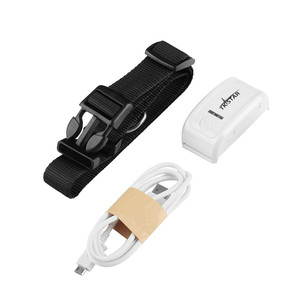(551 products available)


















































































































































































































A GPS tracker pet uses the Global Positioning System (GPS) to track the location of pets. The system is made up of satellites that send signals to GPS devices to determine their location. The devices receive and process the satellite signals to give accurate location information. The trackers are embedded in pets' collars or harnesses and connect to a pet owner's smartphone or computer through a mobile network. This allows the pet owner to track the location of their pet in real time. These devices help prevent pet loss and enable pet owners to monitor their pets' activities. There are various types of GPS trackers for pets, each with its features.
When looking for a pet GPS tracker, it is important to know the specifications of the devices that are going to be purchased. Different devices have different specifications that suit different needs.
Material
The GPS tracker is made of different materials. Some of the materials are nylon, ABS, and silicone. The nylon material is soft and comfortable on the pet's collar. The ABS material is strong and wear-resistant. When looking for a GPS tracker for a dog, consider the material because it will determine the comfort level of the dog.
Battery
The battery is another important part of the GPS tracker. It is important to pay attention to the battery capacity and the battery life of the device. The battery capacity ranges from 120 to 300 mAh. The higher the battery capacity, the higher the battery life. The battery life of a pet GPS tracker ranges from 3 to 10 days. Apart from the battery capacity, consider the charging method. Most GPS trackers have USB charging methods. Some trackers have a solar charging feature.
Waterproof level
Pets are active and playful. They can go anywhere, including muddy places or rainy places. A normal GPS tracker will get damaged or malfunction when exposed to water. Therefore, consider the waterproof level of the GPS tracker. The waterproof level is measured by the IP (Ingress Protection) code. The levels range from IP67 to IP68. A tracker with a higher IP level can be submerged in water for a long time.
Light and size
The weight and size of the GPS tracker should be small. A tracker that is not small can make the pet uncomfortable. The pets might refuse to wear the collar. The weight of the tracker should be light, around 10 grams. There is no standard weight for a pet GPS tracker because different brands have different weights. The size of the GPS tracker varies depending on the design. The size can range from 4 cm to 8 cm in length. Some trackers have a round shape while others have a rectangular shape.
GPS accuracy
Since the purpose of the device is to track the location of the pet, the accuracy of the GPS is an important factor to consider. When a GPS tracker has high accuracy, it can give the exact location of the pet. The accuracy of the GPS system is about 5 to 10 meters. Some advanced trackers have an accuracy level of 1 meter.
Monitor activity
Some advanced pet GPS trackers have a health and activity monitoring feature. The feature allows the owner to monitor the health and activity of the pet. The pet tracker has sensors that monitor the heart rate, calories burned, and activity level of the pet. The monitor can help the owner know when the pet is active or when the pet is sick. The health monitoring feature can give alerts and notifications when the pet is active or when it has abnormal health conditions.
Different GPS trackers for pets have different maintenance requirements. However, here are general maintenance requirements for the devices:
With so many options available, selecting the right GPS tracker for pets can be complicated. Here are some important considerations to facilitate the selection process:
Replacing a broken or faulty GPS tracker for pets is a simple process that can be done at home. Here are the steps to take:
Get the right replacement
It is important to get a tracker that is compatible with the collar of the pet. This ensures easy integration and proper functionality.
Remove the old tracker
Once the new tracker has been acquired, the old one pet GPS tracker device should be removed. This is done by loosening the straps or clips and carefully taking it off the collar.
Prepare the new tracker
The new GPS tracker for pets should be charged fully before installation. The manufacturer’s instructions should be followed during charging to ensure proper battery function.
Attach the new tracker
Once the new GPS tracker for pets has been prepared, it should be attached to the collar. This is done by following the instructions in the manual. The device should be securely attached to the GPS-enabled pet without causing any discomfort.
Test the new tracker
Once the new tracker has been attached to the pet's collar, it should be tested to ensure it is working well. The functionality of features such as location tracking, notifications, and the app interface should be checked.
Dispose of the old tracker
The old GPS pet tracker device should be disposed of in accordance with local regulations. This is important especially if the device contains a battery or other hazardous materials.
Q1: How accurate is the GPS in pet trackers?
A1: GPS accuracy in pet trackers can vary based on several factors. Generally, GPS trackers for pets can provide location accuracy within 5 to 50 meters under ideal conditions. However, accuracy can be affected by environmental factors such as dense foliage, tall buildings, or weather conditions that impact satellite signals. Additionally, the quality of the GPS technology used in the tracker and the availability of satellite signals at the pet's location also play a role in accuracy.
Q2: Can I track my pet in another country with a GPS tracker?
A2: Many GPS trackers for pets with global tracking capabilities use cellular networks and are designed to work in multiple countries. However, verifying that the GPS tracker has international roaming or compatibility with local networks in the desired country is essential. Some trackers may require subscription plans that cover international tracking.
Q3: How long does the battery of a GPS pet tracker last?
A3: The battery life of a GPS pet tracker varies depending on the type of tracker, usage, and tracking frequency. In general, GPS trackers with real-time tracking and frequent updates have shorter battery lives than those with periodic updates. Battery life can range from a few days to several weeks. Choosing a tracker with power-saving features and regularly charging or replacing the battery as needed is essential.
Q4: Are GPS pet trackers waterproof?
A4: While many GPS pet trackers are designed to be durable and water-resistant, not all are entirely waterproof. Water-resistant trackers can withstand exposure to moisture or light rain. If users have pets that swim or are frequently exposed to water, they need to ensure that the tracker is explicitly labeled as waterproof and can withstand prolonged immersion.
Q5: Can I use a GPS tracker for pets on other animals?
A5: GPS trackers for pets are generally designed for cats and dogs. However, some trackers can be used on other small animals like rabbits or ferrets. Before using a GPS tracker on another animal, users need to check the device's size, weight, and suitability for that animal species.